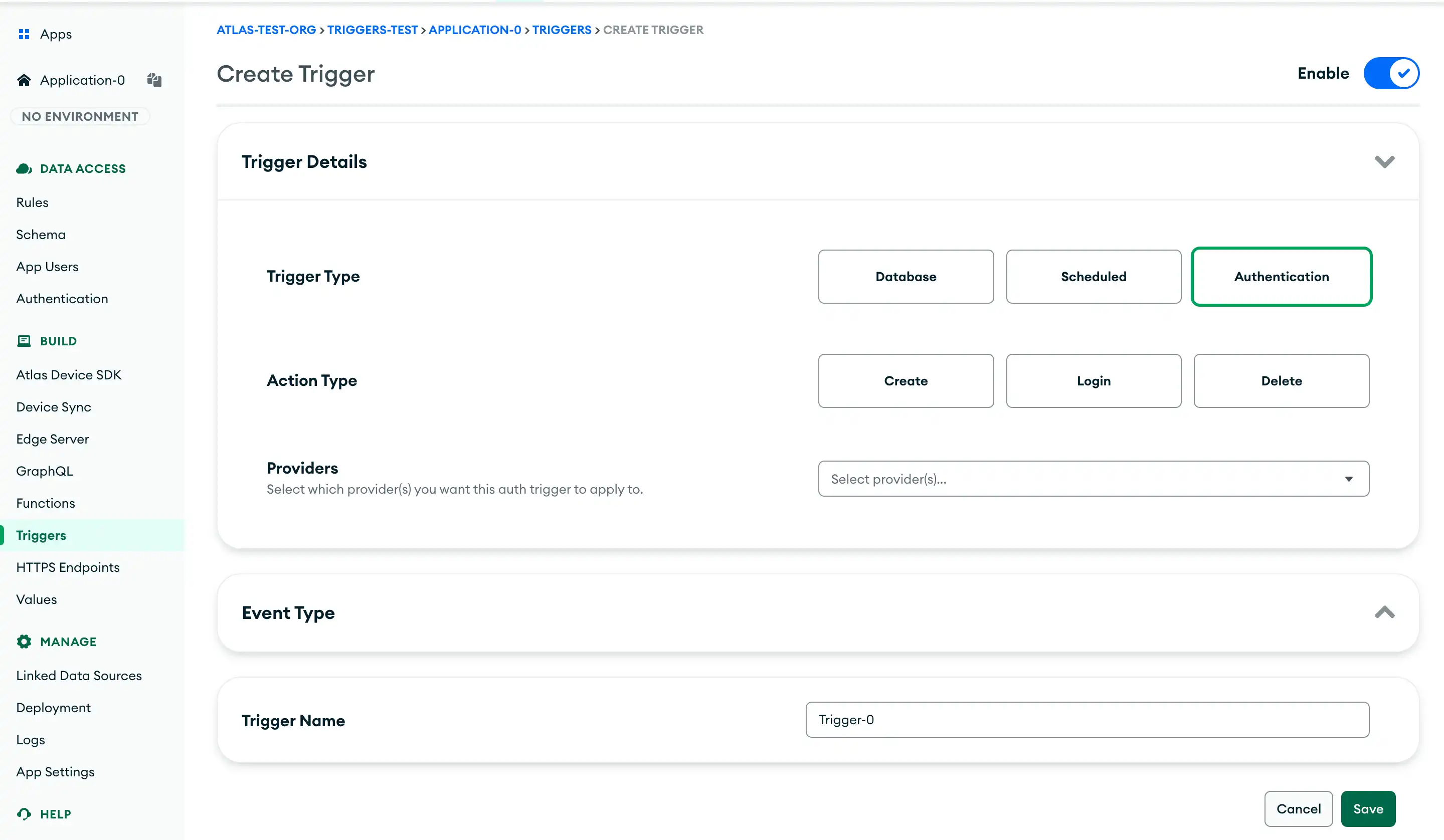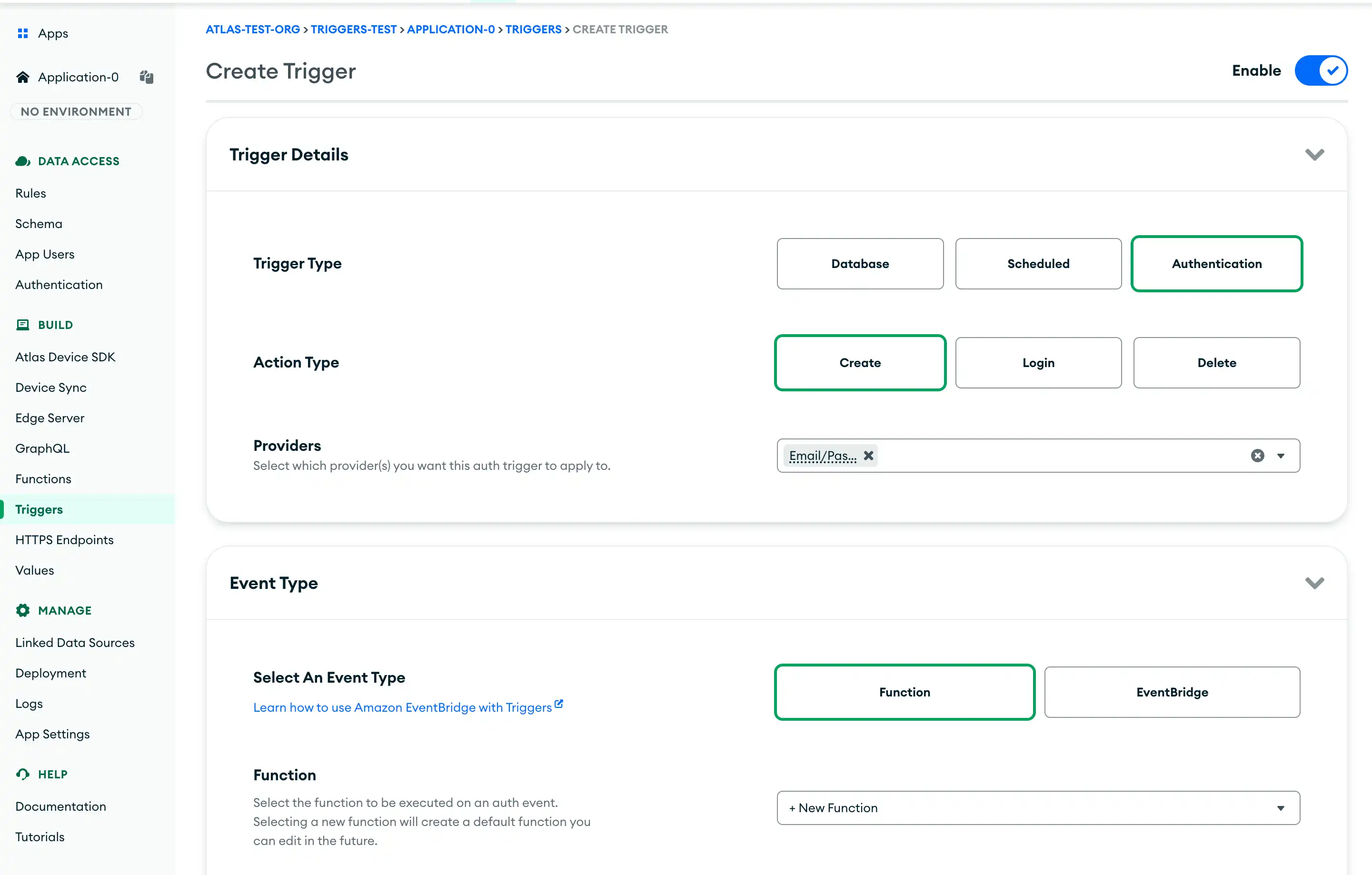An authentication trigger fires when a user interacts with an authentication provider. You can use authentication triggers to implement advanced user management. Some uses include:
Storing new user data in your linked cluster
Maintaining data integrity upon user deletion
Calling a service with a user's information when they log in.
Create an Authentication Trigger
To open the authentication trigger configuration screen in the Atlas App Services UI, click Triggers in the left navigation menu, click Create a Trigger, and then select the Authentication tab next to Trigger Type.
Configure the trigger and then click Save at the bottom of the page to add it to your current deployment draft.

To create an authentication trigger with App Services CLI:
Add an authentication trigger configuration file to the
triggerssubdirectory of a local application directory.Note
App Services does not enforce specific filenames for Atlas Trigger configuration files. However, once imported, App Services will rename each configuration file to match the name of the trigger it defines, e.g.
mytrigger.json.Deploy the trigger:
appservices push
Configuration
Authentication Triggers have the following configuration options:
Field | Description |
|---|---|
Trigger Type | The type of the trigger. For authentication triggers,
set this value to |
Action Type | The authentication operation type that causes the trigger to fire. |
Providers | A list of one or more authentication provider types. The trigger only listens for authentication events produced by these providers. |
Event Type | Choose what action is taken when the trigger fires. You can choose to run a function or use AWS EventBridge. |
Function | The name of the function that the trigger executes when it fires. An authentication event object causes the trigger to fire. This object is the only argument the trigger passes to the function. |
Trigger Name | The name of the trigger. |
Authentication Events
Authentication events represent user interactions with an authentication provider. Each event corresponds to a single user action with one of the following operation types:
Operation Type | Description |
|---|---|
| Represents a single instance of a user logging in. |
| Represents the creation of a new user. |
| Represents the deletion of a user. |
Authentication event objects have the following form:
{ "operationType": <string>, "providers": <array of strings>, "user": <user object>, "time": <ISODate> }
Field | Description |
|---|---|
| The operation type of the authentication event. |
| The authentication providers that emitted the event. One of the following names represents each authentication provider:
NoteGenerally, only one authentication provider emits each event.
However, you may need to delete a user linked to multiple providers.
In this case, the |
| The user object of the user that interacted with the authentication provider. |
| The time at which the event occurred. |
Example
An online store wants to store custom metadata for each of its customers
in Atlas.
Each customer needs a document in the store.customers collection.
Then, the store can record and query metadata in the customer's document.
The collection must represent each customer. To guarantee this, the store
creates an Authentication Trigger. This Trigger listens for newly created users
in the email/password authentication
provider. Then, it passes the
authentication event object to its linked
function, createNewUserDocument. The function creates a new document
which describes the user and their activity. The function then inserts the document
into the store.customers collection.

{ "type": "AUTHENTICATION", "name": "newUserHandler", "function_name": "createNewUserDocument", "config": { "providers": ["local-userpass"], "operation_type": "CREATE" }, "disabled": false }
exports = async function(authEvent) { const mongodb = context.services.get("mongodb-atlas"); const customers = mongodb.db("store").collection("customers"); const { user, time } = authEvent; const isLinkedUser = user.identities.length > 1; if(isLinkedUser) { const { identities } = user; return users.updateOne( { id: user.id }, { $set: { identities } } ) } else { return users.insertOne({ _id: user.id, ...user }) .catch(console.error) } await customers.insertOne(newUser); }
Additional Examples
For additional examples of Triggers integrated into an App Services App, checkout the example Triggers on Github.